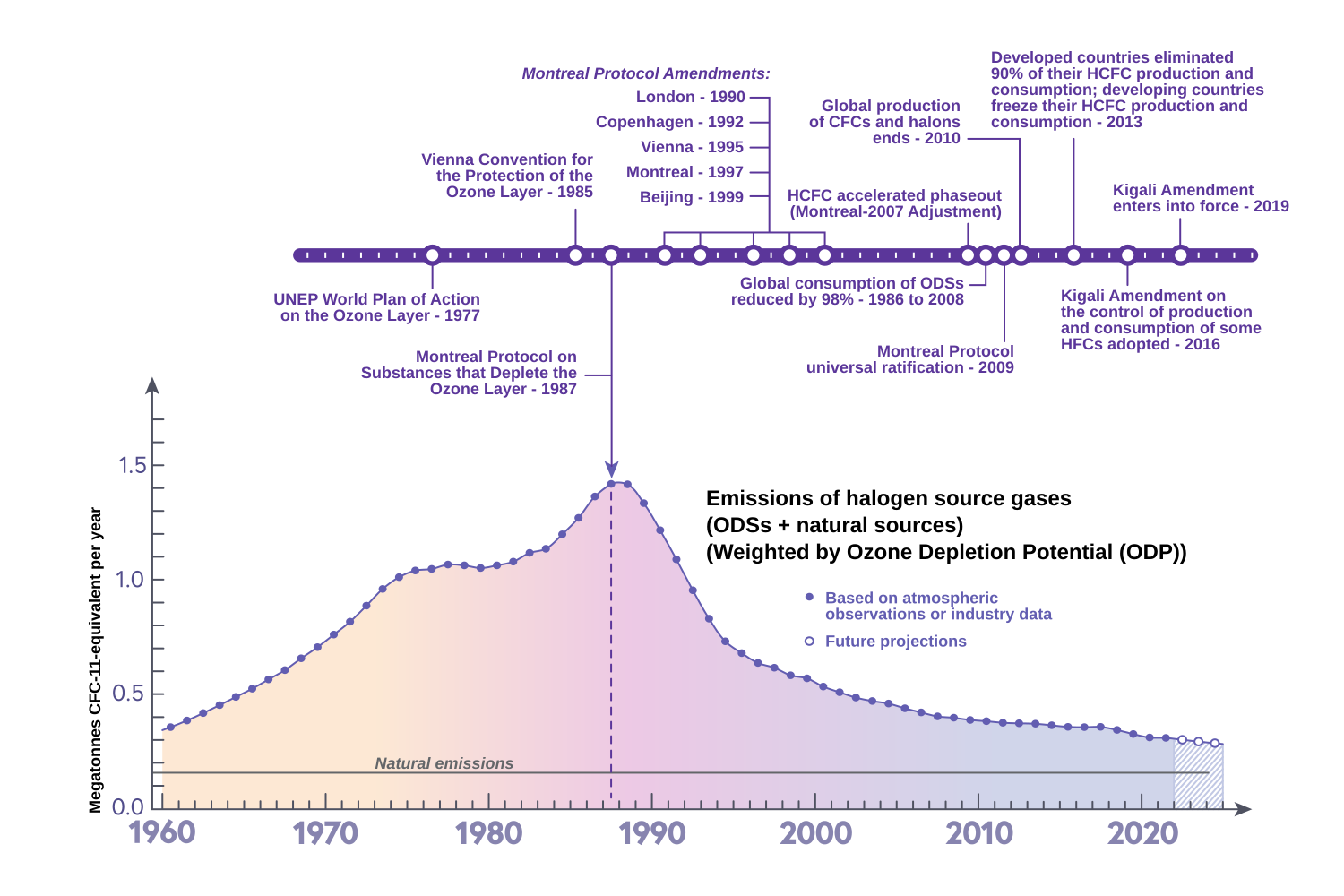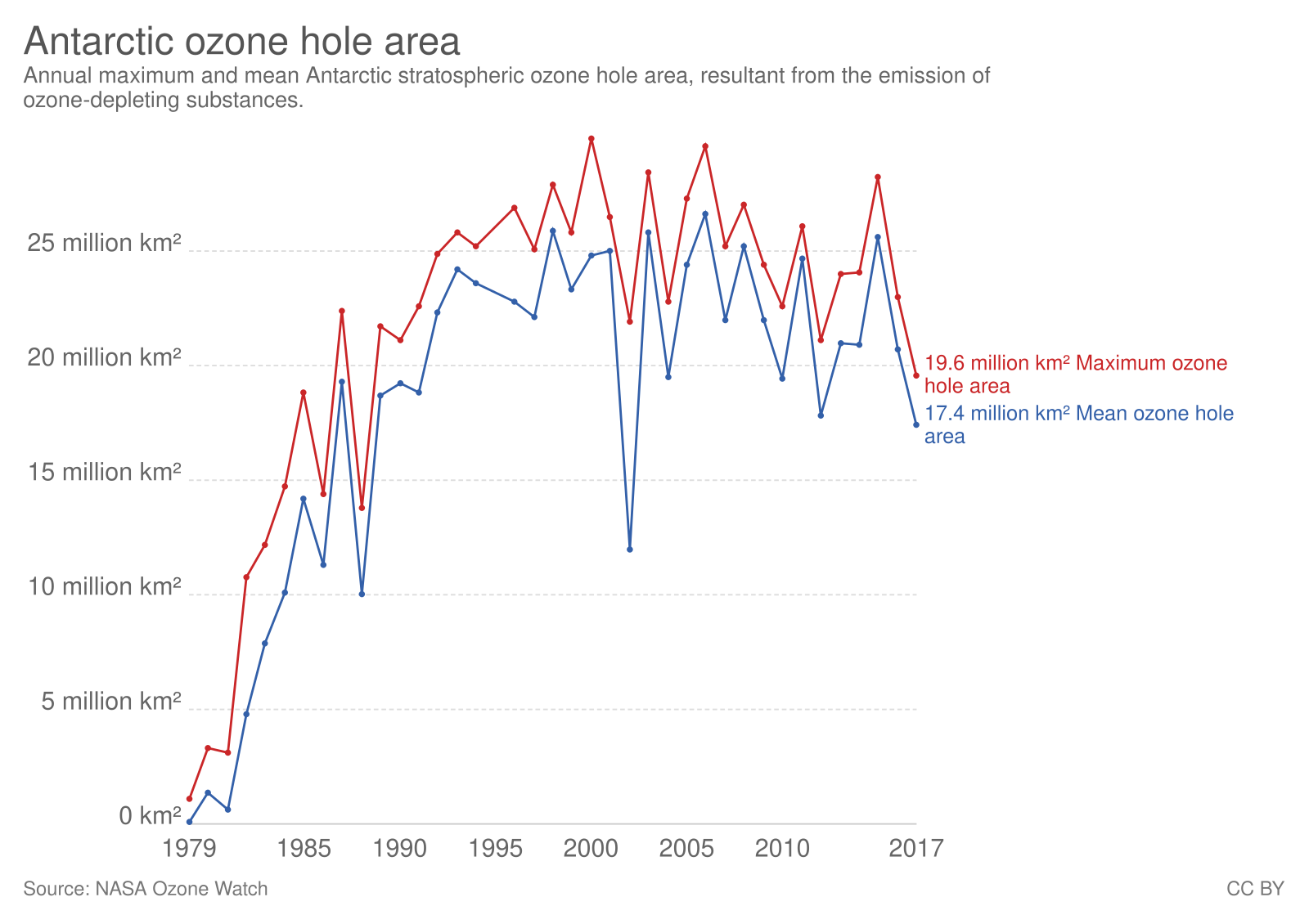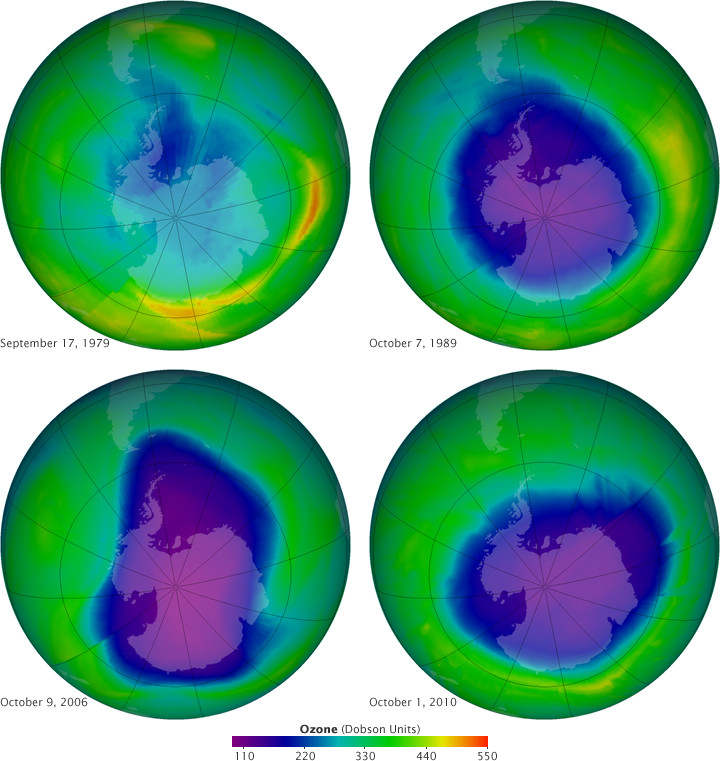IB Syllabus focus:
‘Actions under the Montreal Protocol have prevented crossing the planetary boundary for stratospheric ozone depletion.’
International cooperation has proven vital in protecting the atmosphere. The Montreal Protocol is a landmark agreement that successfully prevented humanity from breaching the planetary boundary for stratospheric ozone depletion, safeguarding ecosystems and health.
Understanding Planetary Boundaries
The concept of planetary boundaries refers to thresholds within Earth system processes that, if crossed, risk destabilising global systems. Ozone depletion is one such boundary. Scientists determined that widespread use of ozone-depleting substances (ODSs) such as chlorofluorocarbons (CFCs) was reducing the stratospheric ozone layer, threatening life by increasing exposure to harmful ultraviolet (UV) radiation.
Ozone-Depleting Substances (ODSs)
ODSs are synthetic chemicals once widely used in refrigeration, air conditioning, aerosol propellants and solvents.
Ozone-Depleting Substances (ODSs): Human-made chemicals, including CFCs, halons, and hydrochlorofluorocarbons (HCFCs), that destroy stratospheric ozone molecules when released into the atmosphere.
These substances are stable in the lower atmosphere, allowing them to reach the stratosphere intact. There, UV radiation breaks them down, releasing chlorine and bromine atoms that catalyse ozone destruction.
The Montreal Protocol
The Montreal Protocol on Substances that Deplete the Ozone Layer, adopted in 1987, is the most significant international environmental treaty addressing ozone depletion. It has achieved near-universal ratification.

Timeline of key policy milestones and their effect on CFC-11-equivalent emissions, illustrating how concerted international action drove down ozone-depleting substances. The figure aligns with evidence-based governance central to the Montreal Protocol. Minor details on specific amendment dates are included beyond the IB specification but help explain the mechanism of success. Source.
Key Features
Legally binding controls on production and consumption of ODSs.
Differentiated responsibilities, giving developing nations longer timelines for compliance.
Regular scientific assessments to update control measures.
Amendments and adjustments, such as the London (1990) and Kigali (2016) Amendments, tightening restrictions and including additional substances.
The Protocol’s flexibility and reliance on scientific evidence made it a model for environmental governance.
Boundary Avoided through Action
By drastically reducing global ODS emissions, the Montreal Protocol prevented the ozone boundary from being crossed. Without intervention, models predicted a dramatic increase in surface UV radiation, leading to severe ecological and societal damage.
Key avoided consequences include:
A large-scale rise in skin cancer and cataracts in humans.
Severe declines in phytoplankton productivity, reducing oceanic food webs and carbon cycling.
Crop yield losses due to UV-induced damage to plant DNA.
Greater stress on ecosystems already facing biodiversity threats.
Thus, global cooperation directly averted irreversible harm.
Planetary Boundary Concept and Ozone
The planetary boundary for ozone is defined by the concentration of ozone in the stratosphere required to block biologically damaging UV radiation. Scientists concluded that this threshold was dangerously close to being breached in the 1980s. The Montreal Protocol stabilised the system, keeping ozone concentrations above the minimum safe limit.
Planetary Boundary (Ozone): The threshold of stratospheric ozone concentration below which harmful levels of UV radiation reach Earth, increasing risks to health and ecosystems.
This demonstrates the importance of early intervention to prevent system collapse.
Evidence of Recovery
Monitoring shows that ozone depletion is slowing, with signs of ozone layer recovery since the late 1990s. Projections suggest a return to pre-1980 ozone levels by the middle of the 21st century, assuming continued compliance. The Antarctic ozone hole, once a symbol of crisis, is gradually shrinking in size and severity.

Annual maximum and mean Antarctic ozone hole area, demonstrating post-Protocol stabilisation and gradual improvement. The chart supports the statement that action has kept ozone within a safer operating space. Minor data annotations extend slightly beyond the syllabus to clarify trends. Source.

Four satellite-derived maps show the Antarctic ozone hole at maximum depletion in selected years (1979, 1989, 2006, 2010), with purple/blue indicating lowest ozone (Dobson Units). The sequence visualises the crisis peak and early signs of improvement following global controls on ODSs. Includes additional contextual details from NASA about instruments and dates beyond the syllabus. Source.
Lessons Learned
The Montreal Protocol illustrates that international cooperation can prevent planetary boundary transgression. Key lessons include:
Science-based policy works when research directly informs decision-making.
Equitable frameworks encourage participation by recognising different national capacities.
Adaptive governance is essential, with treaties that can evolve as new evidence emerges.
Public awareness and advocacy play crucial roles in mobilising political will.
Links to Climate Change
Interestingly, many ODSs are also potent greenhouse gases. Their phase-out contributed to climate mitigation, avoiding warming equivalent to billions of tonnes of carbon dioxide. The 2016 Kigali Amendment, which targets hydrofluorocarbons (HFCs), extends this dual benefit by addressing substances that do not deplete ozone but strongly influence climate.
Broader Implications for Earth Systems
The Montreal Protocol provides a case study in successful planetary stewardship. It demonstrates how collective action can safeguard Earth’s system processes and shows the effectiveness of combining science, policy, and international cooperation. Importantly, it highlights that once boundaries are crossed, recovery may not be possible — but proactive action can avoid catastrophic outcomes.
FAQ
In the 1970s, research by Molina and Rowland showed that CFCs released chlorine atoms in the stratosphere, which catalytically destroyed ozone molecules.
Satellite data in the 1980s confirmed unexpected ozone loss over Antarctica, later called the “ozone hole.” This evidence directly linked human-made ODSs to stratospheric ozone depletion.
The Protocol included legally binding targets, a schedule for phasing out substances, and the ability to adjust quickly as new scientific evidence emerged.
It also created the Multilateral Fund to help developing nations transition, ensuring fairness and global participation.
Extreme cold conditions in the polar stratosphere led to the formation of polar stratospheric clouds.
These clouds provided surfaces for chemical reactions that released active chlorine, making ozone destruction more severe in Antarctica compared to other regions.
Chemical companies developed substitutes for CFCs and other ODSs, such as HCFCs and later HFCs.
This innovation reduced resistance from industry, as alternatives allowed continued production of refrigeration, air conditioning, and aerosol products without worsening ozone depletion.
Countries report production and consumption of controlled substances, which are verified by independent monitoring networks.
Scientific organisations like NASA, UNEP, and WMO track ozone levels with satellites and ground stations, ensuring accurate reporting and detection of violations.
Practice Questions
Question 1 (2 marks)
State one reason why the Montreal Protocol is considered a successful example of international environmental cooperation.
Mark scheme:
Award [1] for identifying the legally binding reduction/phase-out of ozone-depleting substances (ODSs).
Award [1] for recognising that the treaty achieved near-universal ratification/global participation.
(Max 2)
Question 2 (5 marks)
Explain how actions under the Montreal Protocol prevented humanity from crossing the planetary boundary for stratospheric ozone depletion.
Mark scheme:
[1] Reference to reduction/phase-out of ozone-depleting substances (e.g., CFCs, halons).
[1] Explanation that fewer ODSs reduced stratospheric ozone destruction.
[1] Reference to stabilisation of ozone concentrations above critical threshold/planetary boundary.
[1] Description of avoided impacts, e.g., reduced risk of increased UV radiation causing skin cancer, crop damage, or ecosystem disruption.
[1] Clear link made to planetary boundary concept (thresholds preventing destabilisation of Earth system processes).
(Max 5)

